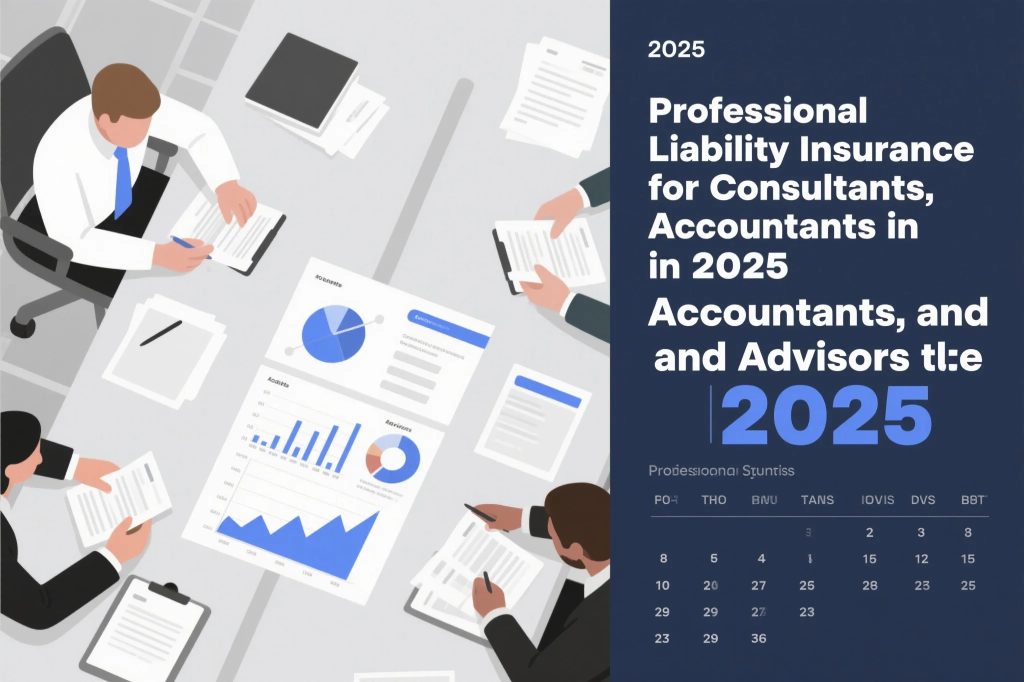The landscape of professional liability insurance for consultants, accountants, and advisors in 2025 is more complex and essential than ever before. As the professional services sector continues to evolve, the risks associated with providing expert advice, financial guidance, and consulting services have grown in both scope and severity. Professionals in these fields face a unique set of exposures that can threaten their reputation, financial stability, and long-term business viability. The increasing litigiousness of clients, the complexity of regulatory requirements, and the heightened expectations for accuracy and ethical conduct all contribute to a risk environment where even a single mistake or perceived oversight can result in devastating claims. In this context, professional liability insurance is not just a safety net—it is a strategic asset that enables consultants, accountants, and advisors to operate with confidence, pursue new opportunities, and protect their hard-earned reputations. The right insurance coverage provides a critical layer of defense against claims of negligence, errors, omissions, and malpractice, ensuring that professionals can focus on delivering value to their clients without the constant fear of financial ruin from an unexpected lawsuit. As we move further into 2025, the importance of tailored, robust professional liability coverage will only continue to grow, making it imperative for every consultant, accountant, and advisor to understand the nuances of available policies and the best practices for integrating insurance into their broader risk management strategies.
Malpractice Insurance: Shielding Your Practice from Costly Claims
For professionals in consulting, accounting, and advisory roles, malpractice insurance serves as a vital shield against the potentially catastrophic financial consequences of client claims. Malpractice insurance, often used interchangeably with professional liability insurance, is specifically designed to cover legal defense costs, settlements, and judgments arising from allegations of professional negligence, errors, or omissions. In 2025, the scope of malpractice claims has expanded, with clients increasingly willing to pursue legal action over perceived missteps, missed deadlines, or unsatisfactory outcomes. The rise of digital service delivery, remote work, and complex financial instruments has further complicated the risk landscape, making it easier for misunderstandings or technical errors to escalate into full-blown disputes. For consultants, a single miscalculation in a business strategy can lead to significant client losses and subsequent litigation. Accountants face exposure from tax filing errors, audit oversights, or compliance failures, while advisors must navigate the minefield of investment recommendations and fiduciary duties. Malpractice insurance not only covers the direct costs of defending against such claims but also provides invaluable support in managing reputational damage and maintaining client trust during challenging times. The best policies in 2025 offer broad definitions of covered acts, flexible limits, and access to expert legal counsel, ensuring that professionals are equipped to handle even the most complex and high-stakes claims. By investing in comprehensive malpractice insurance, consultants, accountants, and advisors can safeguard their practices, protect their personal assets, and demonstrate a commitment to responsible, client-focused service.
Risk Transfer Strategies for Modern Professionals
In an era marked by heightened client expectations and rapidly evolving risks, effective risk transfer strategies are essential for consultants, accountants, and advisors seeking to protect their businesses and personal assets. Risk transfer involves shifting the financial burden of potential losses from the professional to an insurance provider, allowing individuals and firms to focus on growth and service delivery without being paralyzed by the fear of litigation. The most successful risk transfer strategies in 2025 go beyond simply purchasing a standard insurance policy; they involve a holistic approach to identifying, assessing, and mitigating exposures across all aspects of professional practice. This includes conducting regular risk assessments, implementing robust internal controls, and maintaining clear, well-documented client communications. For consultants, risk transfer may also involve contractual provisions that limit liability or require clients to acknowledge certain risks. Accountants and advisors can benefit from engagement letters that clearly define the scope of services and outline dispute resolution mechanisms. The integration of risk transfer strategies with professional liability insurance ensures that coverage is tailored to the unique needs of each practice, providing peace of mind and financial security in the face of uncertainty. As the professional services landscape continues to evolve, those who proactively manage their risk profiles and leverage advanced risk transfer techniques will be best positioned to thrive in a competitive and challenging environment.
Asset Protection Planning: Safeguarding Your Wealth and Reputation
For consultants, accountants, and advisors, asset protection planning is a critical component of long-term business success and personal financial security. The threat of professional liability claims, regulatory investigations, and client disputes means that even the most diligent professionals can find themselves facing significant financial exposure. Asset protection planning involves a combination of legal, financial, and insurance strategies designed to shield personal and business assets from creditors, litigants, and unforeseen liabilities. In 2025, the most effective asset protection plans are those that integrate professional liability insurance with other tools such as trusts, limited liability entities, and retirement accounts. By structuring their affairs strategically, professionals can ensure that their homes, savings, and investments are insulated from the fallout of a lawsuit or malpractice claim. Additionally, asset protection planning enhances negotiating leverage in the event of a dispute, as claimants may be less inclined to pursue aggressive litigation against well-protected individuals. For consultants and advisors, demonstrating a commitment to asset protection can also enhance client confidence and serve as a differentiator in a crowded marketplace. Ultimately, the goal of asset protection planning is not to evade responsibility but to provide a fair and reasonable defense against excessive or unfounded claims, allowing professionals to focus on delivering value and building lasting client relationships.

Fraud Protection Insurance: Defending Against Emerging Threats
The rise of sophisticated fraud schemes and cyber threats has made fraud protection insurance an indispensable element of risk management for consultants, accountants, and advisors in 2025. As trusted custodians of sensitive client information and financial data, these professionals are prime targets for fraudsters seeking to exploit vulnerabilities in systems and processes. Fraud protection insurance provides coverage for losses resulting from employee dishonesty, cybercrime, social engineering attacks, and other fraudulent activities that can cause significant financial and reputational harm. In addition to reimbursing direct losses, the best fraud protection policies offer access to forensic experts, crisis management support, and legal counsel to help professionals respond effectively to incidents and minimize long-term damage. For accountants, the risk of internal fraud or embezzlement is a constant concern, while consultants and advisors must guard against phishing attacks and data breaches that could compromise client confidentiality. By investing in comprehensive fraud protection insurance and implementing robust security protocols, professionals can demonstrate their commitment to safeguarding client interests and maintaining the highest standards of ethical conduct. In a world where the threat landscape is constantly evolving, proactive fraud protection is not just a defensive measure—it is a competitive advantage that can set leading professionals apart from their peers.
The Future of Professional Liability Insurance: Trends and Best Practices
As we look ahead to the future of professional liability insurance for consultants, accountants, and advisors, several key trends and best practices are emerging that will shape the industry in 2025 and beyond. The increasing complexity of client engagements, the proliferation of digital services, and the globalization of professional practice are all contributing to a risk environment that demands more sophisticated and flexible insurance solutions. Insurers are responding by offering policies with broader coverage definitions, higher limits, and enhanced support services such as risk management consulting and claims advocacy. Professionals are also taking a more active role in managing their risk profiles, leveraging technology to monitor exposures, and participating in continuing education to stay abreast of regulatory changes and industry developments. The integration of professional liability insurance with other risk management tools—such as malpractice insurance, asset protection planning, and fraud protection insurance—will become standard practice for leading firms and individuals. By staying informed about emerging risks, investing in comprehensive coverage, and adopting proactive risk management strategies, consultants, accountants, and advisors can ensure that they are well-prepared to navigate the challenges and opportunities of the modern professional landscape. In this dynamic environment, professional liability insurance is not just a requirement—it is a cornerstone of sustainable success and client trust.
